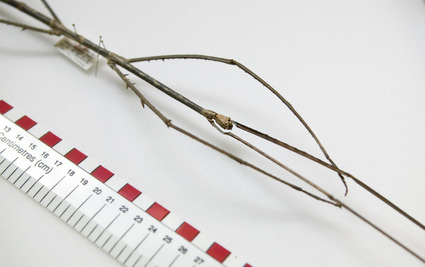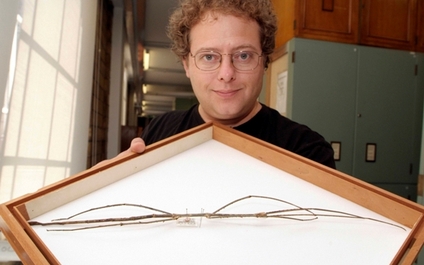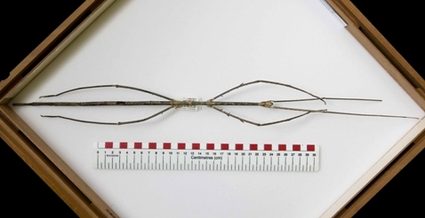The World’s Longest
Posted by: Loren Coleman on November 3rd, 2008

Are you looking into her eyes? What are you looking at in the photograph above?
Did you see Chan’s megastick (Phobaeticus chani) beneath the arms of the young woman?
Recently named the world’s longest living insect, the thin, bamboo-looking stick insect—best known for its camouflaging abilities to deter predators—was discovered in Southeast Asia’s island of Borneo. Measuring approximately 22 inches long with its legs, or 14 inches just counting its body, megastick swiped away the title from its previous record holder of more than a century, Phobaeticus kirbyi—also a stick insect from Borneo—by almost an inch. Further, scientists in England have confirmed it is a new species of stick insect, adding to the 3,000 known species of the bug mainly found in the tropics and subtropics.



Although British scientists formally announced the new record holder during October, the dead, female stick insect was found in Borneo’s rainforests by a local collector around 30 years ago. It was not until a decade later in 1989 that Malaysian naturalist, Datuk Chan Chew Lun, whom the insect is named after, saw the villager’s collection and noticed the insect, also full of eggs, as a new species. Megastick was later passed on to scientists in England, where it now has a new home in the Natural History Museum in London.

About Loren Coleman
Loren Coleman is one of the world’s leading cryptozoologists, some say “the” leading living cryptozoologist. Certainly, he is acknowledged as the current living American researcher and writer who has most popularized cryptozoology in the late 20th and early 21st centuries.
Starting his fieldwork and investigations in 1960, after traveling and trekking extensively in pursuit of cryptozoological mysteries, Coleman began writing to share his experiences in 1969. An honorary member of Ivan T. Sanderson’s Society for the Investigation of the Unexplained in the 1970s, Coleman has been bestowed with similar honorary memberships of the North Idaho College Cryptozoology Club in 1983, and in subsequent years, that of the British Columbia Scientific Cryptozoology Club, CryptoSafari International, and other international organizations. He was also a Life Member and Benefactor of the International Society of Cryptozoology (now-defunct).
Loren Coleman’s daily blog, as a member of the Cryptomundo Team, served as an ongoing avenue of communication for the ever-growing body of cryptozoo news from 2005 through 2013. He returned as an infrequent contributor beginning Halloween week of 2015.
Coleman is the founder in 2003, and current director of the International Cryptozoology Museum in Portland, Maine.










I happen to be a biology teacher and have a love for all animals great and small. I appreciate nature in all of its various forms and find beauty in even spiders, bats, and snakes. But for some reason I am completely and irrationally terrified by stick insects. I remember finding one perched upon me when I woke up one morning in a tent in South east Asia and I screamed like a little girl. And that wasn’t even a particularly big one. So much for a rational scientific mind. 🙂
Thanks for the nightmares tonight.
Regarding the photograph of the woman at the top of the page, maybe she just believes in the old adage, ‘walk softly and carry a big stick {insect}’….
;~)°
I remember a trailless ridge in Virginia’s Shenandoah National Park that a friend and I called Walkingstick Ridge for the numbers of them we found.
But none of them was that big. HUGE bear pies. But no megasticks.
Roast them and you have the Bornean Footlong!
” …adding to the 3,000 known species of the bug mainly found …”
indeed not a bug, I generally do not mind others using it as a common word to refer to all insects (or spiders or other creepy crawleys) but I think when used in an article about insects it should be reserved for referring to the hemiterans. a stick insect is not a hermipteran it is in a different order, phasmatodea, and therefore not a bug.
Im just nitpicking as per usual loren, sorry.
It’s interesting that insect physiology allows for a creature this lengthy. I’m thinking not so much of the inefficient system insects use to circulate oxygen (with a thin body like this, it should work fine) but of the limits of an exoskeleton when you stretch it out to this degree (picture taking a very thin soda straw and seeing how long it can get and still hold up as you press the “foot” end down for locomotion). I am wondering if this is about as long as an insect can get.
I’ve seen one that would go close – in the New England area of New South Wales, Australia… along with the giant cicadas I’m still trying to track down, and some very very aggressive wolf spiders…
Fetch, Rover! Fetch, boy! Fetch the … oh, shoot!
Fascinating.
Good new name:
“Stick-in-the-mud.”